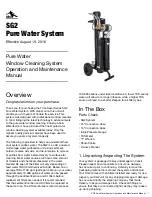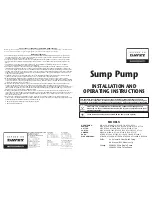
Base Products Corporation www.basepump.com 800 554 1426
page 6
Models: RB750, HB1000, CB1500 Copyright by Base Products Corporation 2015 Rev. May/2015
Clamp to Pipe
_________________________________________________________________
Step 6. Connect Water Supply
See recommended pipe and sizes on page 2. Use approved plumbing procedures and materials to connect the water
supply from your home water source to the pump.
NOTE:
Flush the water pipe before final connection to the pump to remove any debris that may be inside the pipe
before it clogs or damages the Ejector.
PRO-V Models Only:
This model includes a vented dual check valve along with a drain hose. Connect the drain hose
to the barbed fitting on the Dual Check Valve Vent, turn the valve so the drain faces the floor, and direct the hose into
the sump.
_________________________________________________________________
Step 7. Install Water Alarm (see specifications with alarm)
Install the battery:
Remove battery compartment cover on the back of the alarm. Pull out float and wire stored inside.
Snap a 9-volt battery onto the battery connector, place the battery inside compartment, line up float wire into slot at
bottom of alarm, and replace cover.
Mount the Alarm:
Stick plastic cable tie mount to upper back of alarm; wrap releasable cable tie
through the mount and around the suction pipe ~4 feet above floor,
or to a wall using screws.
Position the sensor float:
Clamp bracket to the pipe (shown here) or screw to the sump wall.
Typical height would be just above the normal high water level in the sump, so it alarms at the
same time as the pump turns on.
Replace the battery
when the alarm has operated for an extended period of time. Alarm will
“chirp” when the battery needs to be replaced. A new battery should last a year, on standby.
Relay Outputs:
These are no volt,
Normally Open
,
“dry” contacts that close when the alarm
sounds and open when it stops. These may be connected to a security system or auto-dialer.
Operation:
When the float is up the alarm sounds and the relays close. When float drops, the alarm will silence and
the relays will open.
Start Up Procedure
Open the water shut-off valve and check for leaks.
Note:
Pump may turn on at this time so be sure the discharge piping is
completed. Lift the float ball for 10 seconds to release air trapped in the Ejector and Transfer Tube. Air and water will
release from the drain port on the float unit just above the float ball. The first cycle may take longer than normal to shut off.
Factory setting is approximately
30 seconds after the float ball drops
to its lowest position. Pump should stop after 30-
60 seconds. Lift the float a second time after the first run is over. If pump continues running too long or shuts off too
quickly, see
“Adjusting the Timing Control”
on page 8.
Operating Instructions
Pump operates automatically. To operate manually, lift the float ball in the sump to its upper position for a few seconds till
the water starts running and then lower it, simulating a normal rise and fall of the water and allowing the pump to operate
through a complete cycle. This flushes the water pipes and confirms that the pump is functioning properly.
Periodic Testing Procedures
It is necessary to test this pump at least once every 3-4 months to ensure proper basement flood protection and to protect
your warranty. Follow the procedures noted here, write down each of your test dates, and keep it with these instructions in
a convenient location on or near the pump.
Confirm that:
When float ball is lifted, water flows from the port just above the float ball and the pump turns on.
The pump runs and removes water from the sump at a normal rate.
Pump then turns itself off approximately 30-40 seconds AFTER the float ball drops to its lowest position. This is the
factory setting, but it may have been adjusted to run longer or shorter depending on sump water inflow rates. If
needed, see
“Adjusting the Timing Control”
on page 8.
Water should stop flowing from the port above the ball when you lower the float ball.
Water Supply
Water Alarm Kit


























